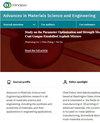油气井钻探过程中的清孔:洗孔化学和工程参数综述
4区 材料科学
Q2 Engineering
引用次数: 0
摘要
钻井作业中高效的清孔对于保持高穿透率和顺利钻进至关重要,可将钻井问题降到最低,提高经济钻井效率。这一过程涉及多个重要因素,包括卡管事故、环空腔内较高的切屑浓度、钻杆振动噪音、不稳定的等效循环密度、失循环事故、井控事故、地质力学孔段不稳定、绊钻作业期间的紧点以及用于调节孔段和泥浆的化学添加剂的过量使用。各种方法,包括相关性、方法学、开发、算法、设备、图表、现场经验、化学品以及涉及实验的研究,都可用于提高清孔效率。开发清孔模型非常重要,可用作清孔指标,确保优化钻井效率。本文全面概述了油气行业复杂的孔清洗领域。它包括技术、工具、模型和化学添加剂。它还包括钻井工程、操作和化学。本文概述了钻井液在促进钻屑运输、保持孔段稳定、冷却和润滑钻头以及传递液压马力等方面的重要作用。研究还介绍了化学添加剂(包括纳米颗粒、天然聚合物、改性聚合物和合成聚合物)在保持井筒稳定性、提高钻井效率和降低钻头磨损方面的重要作用。最后,本研究还提出了进一步研究的建议,以帮助读者澄清钻孔清理问题,提高钻井效率。本文章由计算机程序翻译,如有差异,请以英文原文为准。
Hole Cleaning during Drilling Oil and Gas Wells: A Review for Hole-Cleaning Chemistry and Engineering Parameters
Efficient hole cleaning during drilling operations is critical to maintain a high rate of penetration and smooth drilling, leading to minimum drilling problems and economical drilling efficiency. This process involves several important factors, including pipe-sticking incidents, higher cuttings concentrations in the annulus, noisy vibration of the drill string, erratic equivalent circulating density, lost circulation incidents, well control incidents, geomechanical hole section instability, tight spots during tripping operations, and excessive usage of chemical additives for conditioning hole sections and mud. Various approaches, including correlations, methodologies, developments, algorithms, equipment, charts, field experience, chemicals, and studies involving experiments, can be used to enhance the efficiency of hole cleaning. The development of hole-cleaning models is important for use as hole-cleaning indicators to ensure optimized drilling efficiency. This paper presents a comprehensive overview of the complex field of hole cleaning in the oil and gas industry. It includes techniques, tools, models, and chemical additives. It also encompasses drilling engineering, operations, and chemistry. To facilitate the transit of drill cuttings, maintain hole section stability, cool and lubricate the drill bit, and transmit hydraulic horsepower, this article outlines the important roles of drilling fluids. The significance of chemical additives, including nanoparticles, natural and modified polymers, and synthetic polymers, in preserving wellbore stability, improving drilling efficiency, and lowering drill bit wear is also covered in the study. It concludes by making recommendations for further study to clarify hole cleaning for the reader to facilitate and boost drilling efficiency.
求助全文
通过发布文献求助,成功后即可免费获取论文全文。
去求助
来源期刊

Advances in Materials Science and Engineering
Materials Science-General Materials Science
CiteScore
3.30
自引率
0.00%
发文量
0
审稿时长
4-8 weeks
期刊介绍:
Advances in Materials Science and Engineering is a broad scope journal that publishes articles in all areas of materials science and engineering including, but not limited to:
-Chemistry and fundamental properties of matter
-Material synthesis, fabrication, manufacture, and processing
-Magnetic, electrical, thermal, and optical properties of materials
-Strength, durability, and mechanical behaviour of materials
-Consideration of materials in structural design, modelling, and engineering
-Green and renewable materials, and consideration of materials’ life cycles
-Materials in specialist applications (such as medicine, energy, aerospace, and nanotechnology)
 求助内容:
求助内容: 应助结果提醒方式:
应助结果提醒方式:


